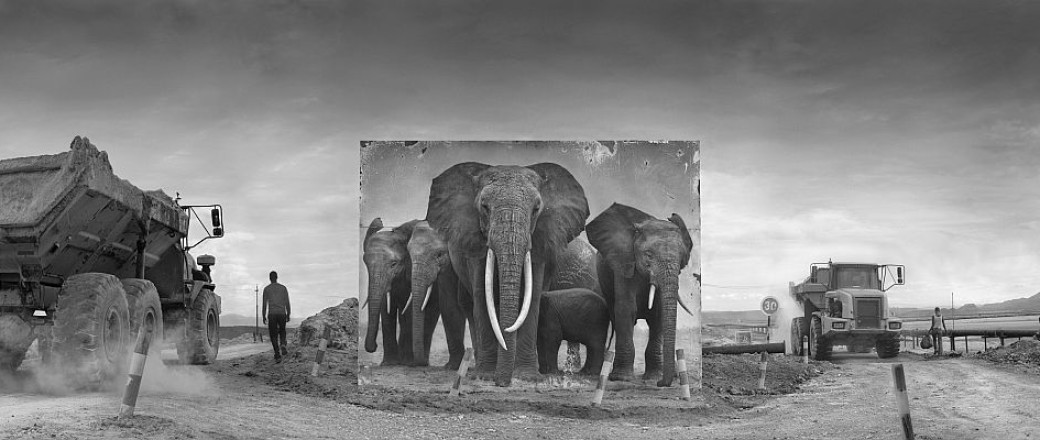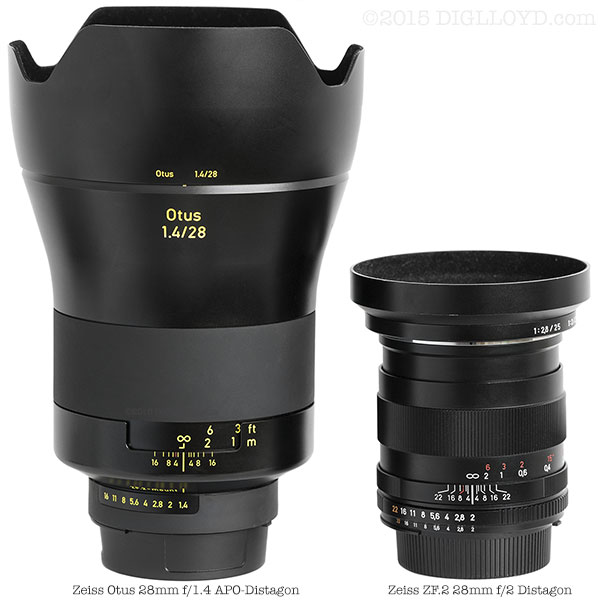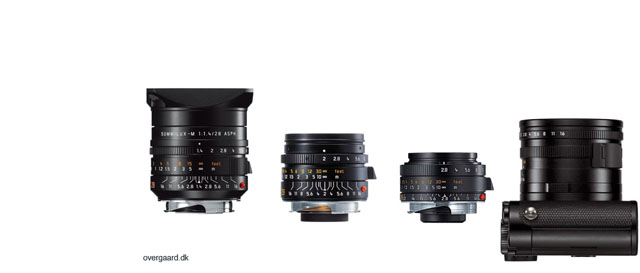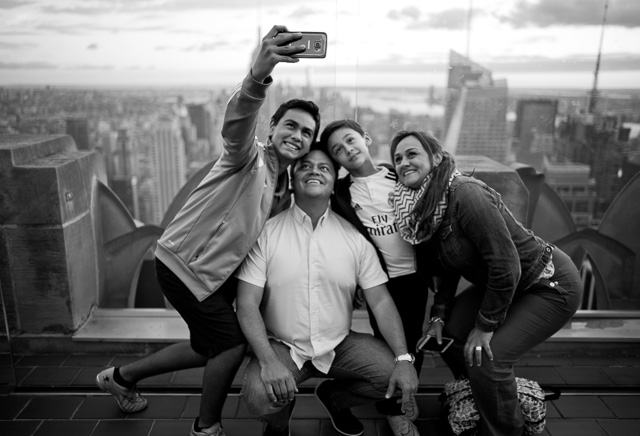Posts
-
Leicaflex Standard

(From: hyperfocalpoint.com)The first Single-Lens-Reflex Leica, introduced 1964, ten years after the Leica M3, five years after the Nikon F. And more expensive at the time than those two.. In four years Leica produced 37500 pieces, while Nikon sold a million Fs in ten years.
There is one feature that separates the Leicaflex from every other camera. While it has a through the lens viewfinder, the viewing screen is not matte. That means the look is similar like a range finder, that wherever your eyes focus to it is sharp (to some degree), while with the matte screen if it is not in focus your eye also can not see it sharp. While I prefer to see as much as possible how the final photo will look like, some people see this as a major advantage of a rangefinder, that for composing and framing everything is sharp all the time, even the final photo might have just a selected area that will be really sharp on the photo.
Anyway, the camera seems to be able to make as good photos as any leica ever did.

(From: Rob F) - with Leica Elmarit-R 60mm f/2.8 Macro and Ilford FP4.
(From: Rob F) - with Leica Elmarit-R 90mm f/2.8 and Pan F+.
(From: Claudia)
(From: Claudia)
(From: Hoon Rhee)
(From: Eileen Abrigo)
(From: Claudia)
(From: Claudia) -
365 Days Project
So tomorrow I will finish my »365 Days Photo Project«, but it is only half the story, as I plan to publish the results one by one exactly one year later.
So here is the link to the separate 365 blog location.
-
Jeff Miller with Leica Summicron 50mm

(From: Jeff Miller)At least I think it is made with the Leica Summicron 50mm version 5 lens, and if so I am proud to have contributed a little to this photo by providing the lens:). I think the CCD sensor of Jeff’s Leica M9 adds nicely to this sujet as well. Of course, you have to see it, and “exposure for the highlights” (as they say).
-
Leica Summaron 35mm f/3.5 on Leica M2

(From: Elie Bescont)A very beautiful combo.. (click into the thumbnail for the full picture)
-
Two Shots with Nikkor 50mm f/1.2 AI-S
-
Tom A on 21mm Rangefinder Lenses
The 21mm Troika, Biogon C, Super Elmar, and Super-Angulon.

(From: T&T and Mr B Abrahamsson)Here is a nice thread on Rangefinderforum, started and supported by Tom A, about the top “slow” 21 mm rangefinder lenses:
The “slow” 21mm’s - Se 21f3.4/SA 21f3.4/C Biogon 21f4.5 and more
(From: T&T and Mr B Abrahamsson)
(From: T&T and Mr B Abrahamsson) -
Leica Elmarit-R 35mm Bokeh

(From: Windman Photography, with Canon EOS 5D Mark II)
(From: Windman Photography, with Canon EOS 5D Mark II)BTW, on paper the shortest focussing distance for the Elmarit is 30 cm, but you can turn the barrel quite a bit further (looks like almost 25cm). After measuring I would say the minimal distance is about 3 mm below 27 cm. Did you rough comparison with the Summicron R and that one goes to 28.5 cm. The Summilux-R only can go to 50cm (on paper, didn’t check myself).
Of course, shortest distance is quite important for maximum Bokeh effect. E.g. the Minolta MD 35mm f/2.8 also only goes to 30 cm (maybe a cm below).
And two more..

(From: Windman Photography, with Canon 5D Mark ii)
(From: cup kamuy, with Pentax K-5)The last one has not been made with a full frame sensor but an APS-C camera, in case you wondered.
For reference: Leica Elmarit-R 35mm tags on Flickr.
-
Voigtländer Bessa RF
A classic car photographed with a classic camera. The Porsche 356 Speedster taken a classic camera, the Voigtländer Bessa RF, and its uncoated Skopar 105mm f/3.5 lens:

(From: Jonathan Barrett Adams)I had the luck to find one on a flea market for EUR 40 (the camera, I mean;). Hopefully it is still working, as I intended to use it. It’s loaded with Portra 160 now (for 20% of the cost of the camera). 120 film for 6x9, 56x88 mm^2 frame size to be presize (resulting in 5.7 times as big frames as with 35mm film).
I didn’t expect to use much of my own photos on this blog (and still don’t do), but let’s give it a try now..

(From: Clemens Lee)
(From: Clemens Lee)
(From: Clemens Lee)2016-07-31, with Sony A7 and Contax 28mm C/Y, plus extension ring for the last two shots.
On The Online Darkroom has a fun post about the RF. Bruce Robbins talks a bit about the challenge of using the tiny viewfinder. Personally I thought the photo was on purpose this way.

(From: Bruce Robbins aka The Online Darkroom, with Skopar 105mm f/3.5)I'd just finished having a moan about the Voigtlander's viewfinder which leads me neatly on to the photo at the top of this post. It's a shot of the stairs in my house which I thought looked quite appealing in the morning sunshine the other day. It was handheld at something like 1/25th of a second, slower than I would have liked but setting the tripod up on the stairs would have been a right pain.
What you see isn't what you get
I like it but you've maybe noticed the composition isn't up to my usual peerless standards (ahem!). That's because the bloody awful viewfinder suffers from bloody awful parallax. Hence the rather large expanse of not-a-lot on the left hand side of the frame. I could have cropped it, of course, but then I'd have nothing to write about. Actually, the framing isn't too bad and I reckon I can just about get away with it. ... The black triangle is actually the edge of the frame. All four corners are shaped like that but I haven't looked to see if it's by accident or design. If the viewfinder had been better or there had been a cold shoe where I could fit an external finder I'd consider hanging onto it. I wouldn't like to glue a shoe on top because it's actually worth a fair amount.
(From: Bruce Robbins, with iPhone)Seeing the photo with the look through the viewfinder it reminds me, I see even much less on my camera. Must find this switch to move from 4.5 back to 9 format :).
The Bessa RF came with three different lenses, named Helomar, Skopar, and Heliar (cost was RM 147, 167, 187 respectively for each, as can be seen on this old advertisement from 1936 below).

(From: cameras@tigin.de)The Skopar is a Tessar like design. The cheaper Helomar design has been used previously for the viewing lens of the Voigtländer Superb TLR (twin lens reflex).
After the war only the Heliar lens has been used, in the last year of production in 1949 even coated (according to Schöbels Voigtländer Archiv). But I could not find any example picture with the coated Color Heliar and the RF.
With Helomar Lens

(From: Steve from HK, with Kodak Ektar 100)
(From: Steve from HK, with Kodak Ektar 100)
(From: Steve from HK, with Kodak Ektar 100)With Skopar Lens

(From: Koji from Tokyo)
(From: Thomas Bayes)
(From: Nasir Hamid)
(From: nathan last photography, with Skopar 105mm f/3.5 and Fuji Acros 100)
(From: tonicito)
(From: tonicito)With Heliar Lens

(From: Xiaole Ju)
(From: P3tr)
(From: Steve M.)And with Lens Unkown

(From: J-Works)
(From: J-Works)There is no dedicated group on Flickr for the Bessa RF, but you can still search after Bessa RF tags.
Bonus: Color Skopar
If you want the Skopar coated, you have to go with the Bessa I and II. Have a look here what that coated lens, now name Color Skopar, can do for you:

(From: Richard Turenne, with Voigtländer Bessa I, Color Skopar 105mm f/3.5, and Kodak Portra 160) -
Ricoh Auto Shot
An interesting camera? What ya say?

(From: Cees-Jan de Hoog)Cees-Jan has a nice page showing the first Japanese rangefinder cameras, who started the world wide conquest of the camera market. Here is what he writes about the Ricoh Auto Shot, which was produced in 1964.
Ricoh also produced some more exotic cameras, like the Auto Shot. At first glance it looked like it was missing a viewfinder until you realised that it was integrated in the light meter cell surrounding the lens. It was also not immediately clear what was the top and what was the bottom of the camera, as the wind knob and strap lug were at the bottom. Wind knob, one may ask? Did not all cameras of that era have wind levers? Yes, but this little camera had in fact a motor wind! Despite its small size it did shoot 36x24mm pictures on standard 135 film. In automatic mode it had a fixed shutter speed of 1/125 s with the aperture being controlled by the light meter. The camera could also be operated in manual mode by selecting the aperture, the shutter speed was 1/30 s in that case.
Focus was set by four indicators for head shot, body shot, group shot, and mountain shot for infinity etc. The range of film speed is also easy to overlook, from 100 to 200 Asa (thought you can choose anything inbetween as well:).
BTW, the Ricoh Auto Shot didn’t seem to be produced in big numbers. However the Ricoh Auto Half from around the same time, a camera which uses only the half of a frame of a 135 film, and therefore can make 72 shot per roll, seemed to be common and still has many shooters showing there stuff e.g. on Flickr.
Closed down a bit the lens exhibits a triangle Bokeh, otherwise only found on some very rare Zeiss lenses for the Rollei mount, e.g. the Zeiss HFT 85mm f/1.4 lens was used in the de Niro movie Taxi.

(From: Wallace Koopman)Wallace Koopman made also another mini report later on with a dozen example photos (or so).
And a third, with half a dozen pictures (exactly - and we choose half of them)!

(From: Wallace Koopman)
(From: Wallace Koopman<
(From: Wallace Koopman) /a>)Oh yes, the camera has a very practical Rikenon 35mm f/2.8 lens.

(From: 東昇)Someone named Matt took the lens off and put it on a digital Sony A7ii.

(From: Matt’s Crazy Lens Adventures)Or..

(From: Matt’s Crazy Lens Adventures)The whole Rikenon 35mm lens Flickr set by Matt can be seen here.
To remove such a lens and to put it on a modern digital full frame camera is a so called lens conversion, and starts with something like this:

(From: Makoto Hanaki)Not for the faint of heart.
OK, to turn to another topic, here we have the common black swan with common white swans shot with the auto shot.

(From: Graffix Mars Fear)And again a black swan chasing a white swan.

(From: Graffix Mars Fear)And at last, more pictures in the picture..

(From: Zeiroku)And if you don’t know what to do, read the manual.
-
Kowa Six
The Kowa Six, yet another 6x6 medium format camera.
Here are two shots, one of and one with it..
Through the viewfinder.

(From: Cédric Fumière)And a yummy coffee with wonderful and creamy bokeh.

(From: tat_hase, with Kowa Six, Prominar 85mm f/2.8, and Portra 160)The Kowa Six was the first attempt in the medium format film market, with two more models to follow. They had quite a big lens offering for their camera bodies, a 19mm fisheye and 35mm ultra wide angle of note.

(From: shakmati)
(From: shakmati)
(From: kowa@tuberadio.ru)Here is the 35mm, still 3mm wider than the Zeiss Biogon 38mm.

(From: Sean Rohde)And a picture with it.

(From: Sean Rohde)Sean Rode aka moominstuff wrote a review of the Kowa Six, later he wrote some comparing remarks with the Bronicas (where the pictures from the 35mm are also from, BTW wonderful article if you like Bronicas:).
Here they are together.

(From: Sean Rohde)Kowa also made nice looking 35mm SLRs, the last one in the early mid 70s was with a fixed 19mm lens, the Kowa UW190, intended for construction or real estate professionals.
But they got squeezed out between the Hasselblads and Bronicas and decided to stay focussed to their core business, which is making binoculars and other optical stuff, which you can still buy today.
Just recently they have come out again with manual lenses for the Micro Four Third mount, reanimating their Prominar brand.
-
Leica R8/R9

(From: Haoming Wang)
(From: Godfrey DiGiorgi, with Leica R8 and Elmarit-R 135mm)
(From: Jesse Seberras, with Leica R9 and Summicron-R 90mm)
(From: InternetCopyFromPrintCopyFromWhoKnows)Things that make me niggle about the R8 and R9:
- I don’t like the chrome line around the black body.
- Viewfinder magnification is 0.75 vs 0.8 for the R6 and 0.9 for the R4 (if some random web pages can be believed). In fact I like the R4 viewfinder very much as it is.
- Overall size, thought I had never had one in my hand, hope this changes soon. But of course the size and look is what makes this camera what it is.
Nice things:
- 1/8000
- the Rolls Royce of the manual focus 35mm SLR cameras and the culmination of a long line of development and one of the last of it in production (not even 10 years ago).
- BTW, with the winder I like the camera much more, but then it is even more over the top.

(From: Jesse Yardley)Finally..
Leica R8 Shutter Sound by Ashley Pomeroy.
The same Ashley Pomeroy who wrote a review of the R8 with Summilux-R 50mm E55. But beware, his Summilux was misaligned, so all shots are soft and dreamy. The better photos were made on the dedicated Summilux review, were he talks a bit about the R8 as well, as well as a photo of the R8. The camera used mostly was a Canon 5Dmarkii however.
What’s missing: a picture with the R8 or R9 and the Summilux-R 35mm. Couldn’t find a single picture on the net.
PS. A couple more shots…

(From: Jesse Yardley, with Fuji Sensia 100)
(From: Wes Bender)With Elmarit-R 90mm:

(From: Wes Bender)
(From: Cris Rose)With Elmarit-R 35mm:

(From: WJ Brink)PPS. And with the ancient Leicaflex Summicron 50mm:

(From: Martin Bruntnell) -
Hen's March with Leicaflex SL2
Photos from Ulrich aka Hen’s March taken with a Leicaflex SL2.
One shot in Black&White in C41 process, one from Vienna, rest is from Aalen I guess.

(From: Hen’s March)
(From: Hen’s March, with Kodak Portra 400)“Indeed, in this case the photo is easy to do. You only need to find the place and the right position.”

(From: Hen’s March, with Elmarit-R 35mm and Kodak Portra 400)
(From: Hen’s March, with Elmarit-R 35mm and Kodak 400CN)
(From: Hen's March, with Kodak Portra 400)German idyll description by Martin Bartholmy: "Nachts kommt hier die Jungend vorbei, hinterlässt ihre tags, morgens hocken die Renter da, stehen dann und wann auf und kratzen mit ihren Krücken an der Garangenwand herum, so lange, bis nachmittags die mittelalten Trinker eintaumeln, ihre Getränke aus dem Heckenversteck kramen, sie schön ordentlich leer machen und dann sauber im Mülleimer entsorgen. ... und am nächsten Morgen wird ein neuer Müllbeutel eingesetzt." 
(From: Hen’s March, with Elmarit-R 35mm and Kodak Portra 400)
(From: Hen’s March, with Summicron-R 50mm and Fuji negative film)Here is the whole Flickr Stream tagged with SL2.
-
Ernst Haas with Leicaflex

(From: Ernst Haas Estate)
(From: Ernst Haas Estate)
(From: LEICA Barnack Berek Blog)A Leica USA advertisement from 1976.

(From: Vintage Paper Ads)Around ten years (1985) later he supposedly said:
“Leica, schmeica. The camera doesn’t make a bit of difference. All of them can record what you are seeing. But, you have to SEE.”
Another quote sourced from the infamous Ken Rockwell is:
“Best wide-angle lens? ‘Two steps backward’ and ‘look for the ah-ha’.”
Yet about the Leica lenses according to Gil Pruitt via photo.net he said:
I bought two of his books last year; In Germany and Color Photography. Both beautiful books that I would encourage anyone with an interest in color photography to take a look at. In the back of in Germany he says:
“Except for the handy little Leica table top tripod, I have not used tripods in connection with the photographs published in this book… I try to keep my equipment to a minimum… A final word on lenses: I used 21mm, 28mm, 35mm, 50mm, 90mm, 135mm and 180mm Leica lenses. What I love about Leica lenses is that they are so incredibly sharp and clear, without ever becoming too harsh. Sharpness alone is not enough.”«
He also mentions that the only filter he uses is occasionally a polarization filter when needed. Cheers!
-
Leicaflex SL2

(From: Matt Phillips)What a Beauty. Click into the image above and press ‘L’ for the full size fun.

(From: old*love|Ted Lau with Summicron R 50mm)The Go-To Man for photos made with the SL2 for me is Hen’s March (some images are not tagged but can be accessed via Google).
Here is everything on Flickr tagged Leicaflex SL2 and here is the Flickrhivemind list.
Of Note:
- 1/2000 all mechanical times.
- Double the price of a Nikon F2 in its time.
- No light seals but light traps.
-
Contax T2

(From: Nuno Oliveira)
(From: They Shoot Film: A Photo Collective, with Kodak Ultramax 400)I think the 38mm of the Contax T2 lens are very very strange, not a slight wide angle like a 35mm, and not yet really a normal lens as a 40mm. Even more so as 35 and 40-42mm are maybe my most favorite focal ranges of all, followed by the 70-75mm range.
The Contax T3 for sure is smaller, maybe more beautiful, has a real super sharp 35mm lens, but the T2 is everything but flimsy and gives you a real wight into the hand. But hey, why compare, both are beautiful and can be used to make wonderful photos - as is the T1, which is like a Minox with a real rangefinder for focussing and also the same lens as the T2.

From: MIKI Yoshihito
Additional reading with photos of all four different color versions from the Japan Camera Hunter: The Contax T2 – the killer compact
MIKI Yoshihito’s Photos of the Contax T2
(Click into each photo to reach the original Flickr source..)
And Some More Contax T2 Example Pictures
(From: Ian Wong, with Agfa Ultra 100)
(From: Miguel Peralta)
(From: Adnan)Last not least a video from Sei Man Choi combining his pictures with the T2:
(Best viewed in full screen mode :)
-
Nick Brandt

Source ‘n Author: Nick Brandt
Source ‘n Author: Nick Brandt
Source ‘n Author: Nick Brandt
Source ‘n Author: Nick Brandt
Source ‘n Author: Nick Brandt
Source ‘n Author: Nick BrandtEach off the above images has a small interesting story behind it, if you follow the links on his names under each photo to his blog.
There are more fascinating images on Google Images.It also happens that there are a few photos of his are exhibited in the Edwynn Houk Gallery in Zurich till 2016-07-16, opening hours are here.
Regarding equipment, in the blog and else I red uses the 6x7 medium format Pentax camera with the 200mm f/4.0 his favorite and most used lens. The most recent photos with the picture in the picture have been made with a Mamiya 6x7 camera, with multiple photos on film and then scanned and stitched together.
Last one:

Source: Inherit the Dust -
The 28mm f/1.4 King and Queen
I neither have the Zeiss Otus 28mm f/1.4 nor the Leica Summilux 28mm f/1.4, I don’t contemplate buying either of them, I don’t even (dare) to dream of them. But then, if a Lamborghini drives by, why look the other way????
So talk is cheap, and without any hands on experience, here it goes:

(Source: Digllod)
(Source: Thorsten Overgaard)First obvious differences are the size and weight. 440 g for the Leica vs. 1.35 kg for the Zeiss in Nikon mount. So in return, the Leica likely will only work nicely in the corners on a Leica camera, while the Zeiss will work perfectly match on a Sony A7 something camera. Second, the Zeiss goes down to 30 cm minimal focussing distance, while the Leica stops at 70 cm. Maybe you can work with a helicoid to go closer, but then on which camera?!
So here is an example with the Leica that goes close to the object, hmm, subject…

Source: Jonathan SlackHere is another black and white from Slack again, also close by..
Now let’s see what Pascal Jappy does with the Zeiss in what he calls medium distance:Yummy.
And a little bit closer:
I think the MTF charts don’t take anything from each other. The Leica might have more field curvature, meaning you can focus on a certain point and might have slightly more sharpness than the Otus (maybe only measurably), while the Otus might be better focussing on a close brick wall and having the corners more or less as sharp as the center. In my book the field curvature is a feature, not a bug. You might get some added bokeh or stronger out of focus effect on top what the f/1.4 aperture will give you anyway.
MTF charts for Otus.
MTF charts for SummiluxLandscape at f/1.4 is something for Astrophotographers, but hey, I am sure if that’s what I wanted, I would find a cheaper solution anyway (how about a Sigma 20mm f/1.4!).
Distortion, which to me is very important, is a wash. 1% each in the same direction. Of course, if no distortion is a must in a 28mm, then there is no way around looking for something that either has the word Biogon in its name or is something of a Biogon design copy.
Otus Bokeh:

(Source: Philbert/Dear Susan)Other Pics from the Summilux:

(by Elan)
(Source: Thorsten Overgaard)
Last not least, my Minolta MD 28mm f/2.8 technically might be able to do this (of course, only stopped down), but I just like the picture:
(Source: Jonathan Slack)
Other links:Kristian Dowling 28mm Summilux Review
Ming Thein 28mm Otus Review (Only one bokeh shot! I mean, then, what do you need the Otus for?! But I like his Zeiss 28mm f/2.0 shots very much!)
So you might ask, which lens would I choose? I prefer the Leica Bokeh and of course the little weight, but for the wonderful close focus bokeh, my vote goes to the Otus. -
LCPP Blog Started!
So to quote my own about page:
“This blog is about anything photography related that I find on the net and like. However, my own photos are published on my personal blog at http://clemenslee.blogspot.com/ instead.”
So let’s see, what I’ll come up with. Cheers!
(fresh from the net, seem’s someone stole it from Steve Olives)
subscribe via RSS










